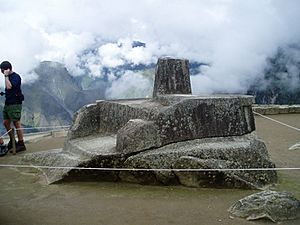Intihuatana, Urubamba facts for kids

Intihuatana
|
|
| Lua error in Module:Location_map at line 420: attempt to index field 'wikibase' (a nil value). | |
| Alternative name | Hitching post of the Sun |
|---|---|
| Location | Peru |
| Region | Cusco Region, Urubamba Province |
| History | |
| Founded | c. 1450 |
| Abandoned | ~ 1535 |
| Cultures | pre-Inca ("megalithic"); Inca |
| Associated with | up to 800 at peak |
The Intihuatana is a very special stone found at the ancient Inca city of Machu Picchu in Peru. Its name, possibly from the Quechua language, means "Hitching Post of the Sun." This stone was very important to the Inca people for understanding the sky.
Machu Picchu was built around 1450 by the Inca ruler, Sapa Inca Pachacuti. It was likely a country home or a special estate. Later, in the 1500s, a Spanish leader named Viceroy Francisco de Toledo and religious leaders tried to destroy these Intihuatana stones. They did this because they thought the Inca religion was wrong. They also worried that the stones' religious meaning could cause political problems. Luckily, the Intihuatana at Machu Picchu was found untouched in 1911 by explorer Hiram Bingham. This showed that the Spanish conquerors never found it.
Sadly, on September 8, 2000, the Intihuatana was damaged. A crane being used for a commercial shoot fell over and chipped a piece of the stone.
What Does the Intihuatana Look Like?
The Intihuatana at Machu Picchu was carved right into the mountain's top. It has many different surfaces, flat areas, and angles. We don't fully understand why it was designed this way.
At its top, there's a slightly sloped flat area. From this area, an upright stone pillar rises. This pillar leans a little bit, about 13 degrees towards the north.
How Did the Intihuatana Work?
Many experts believe the Intihuatana worked like a giant sundial or calendar. It was carefully lined up with the sun's position, especially during the shortest day of the year, called the winter solstice. The Inca people believed this stone helped hold the sun in its place as it moved across the sky each year.
At noon on the spring and autumn equinoxes (when day and night are equal), the sun shines almost directly above the pillar. This means the pillar casts almost no shadow at all. On November 11 and January 30, the sun is also almost exactly above the pillar, casting no shadow.
On June 21, the stone creates its longest shadow on its southern side. On December 21, it casts a much shorter shadow on its northern side. Some people thought the base of the stone looked like a map of the Inca Empire. However, most archaeologists disagree. They point out that the base is short and wide, while the Inca Empire (called Tawantinsuyu) was long and thin.
Pedro Sueldo Nava, a writer, called the Intihuatana "perhaps one of the most beautiful and mysterious places to be found in Machu Picchu."
See also
- Inti, the ancient Inca sun god
- In Spanish: Intihuatana de Machu Picchu para niños
- Machu Picchu


